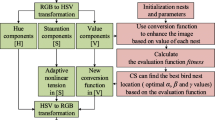Abstract
In order to improve the quality of edge details of remote sensing image and solve the problem of large-scale holes and edge loss in remote sensing image, a new hole filling and optimization algorithm of remote sensing image based on bilateral filtering is proposed in this paper. The compensation function of similarity discrimination and Thiele continued fraction approximate exponential function are used to improve the traditional bilateral filtering algorithm. After the threshold is determined by histogram, the image is binarized to generate hole mask. The constraint term is added to the improved bilateral filtering algorithm for further optimization. According to the characteristics that pixels with the same color have the same gray value in a certain range, the hole area of remote sensing image is filled. The experimental results show that the algorithm can accurately fill the holes in the remote sensing image, not only restore the edge of the image, but also maintain the smoothness of the image. It has good filling performance, high image quality after optimization, image signal-to-noise ratio remains above 32 dB, and time complexity is low.







Similar content being viewed by others
Data Availability
Not applicable.
References
Tao Z, Zhang J, Wang L et al (2019) Image Inpainting Algorithm Based on Edge Feature and Pixel Structure Similarity[J]. J Comput Aided Des Comput Graphics 31(10):1768–1776
Chen Y, Zhang Y (2021) Research on missing pixel filling algorithm of Landsat-7 SLC off image without reference image[J]. Scientia Geographica Sinica 41(7):1276–1284
Lan X, Liu H, Yao H (2018) Improved image inpainting algorithm based on texture block and gradient feature[J]. Comput Eng Appl 54(20):177–182
Wang E, Zhang M, Cheng X et al (2021) Deep Learning-Enabled Sparse Industrial Crowdsensing and Prediction [J]. IEEE Trans Industr Inf 17(9):6170–6181
Zhao T, Yang Y, Wang E et al (2021) Task bundling in worker-centric mobile crowdsensing [J]. Int J Intell Syst 36(9):4936–4961
Dabhade SD, Rathna GN, Chaudhury KN (2018) A Reconfigurable and Scalable FPGA Architecture for Bilateral Filtering[J]. IEEE Trans Industr Electron 65(2):1459–1469
Joshi K, Diwakar M, Joshi NK et al (2020) Cross Bilateral Filter based Image Fusion in Transform Domain[J]. SSRN Electron J 54(04):613–619
Ruchay AN, Dorofeev KA, Kalschikov VV (2019) A novel switching bilateral filtering algorithm for depth map[J]. Comput Opt 43(6):1001–1007
Ghosh S , Gavaskar R G , Chaudhury K N (2019) Saliency Guided Image Detail Enhancement[C]// 2019 National Conference on Communications (NCC). IEEE
AI Jiaqiu, Wang Feifan, Yang Xingming, et al. (2021) SAR image speckle noise suppression algorithm based on background homogeneity and bilateral filtering[J]. J Remote Sensing 25(05):1071–1084.
F Silviu-Ioan, Yuji N , Trefethen L N , et al. (2018) Rational Minimax Approximation via Adaptive Barycentric Representations[J]. SIAM J Sci Comput 40(4):2427–2455
Liu S, Wang S, Liu X et al (2021) Human Memory Update Strategy: A Multi-Layer Template Update Mechanism for Remote Visual Monitoring [J]. IEEE Trans Multimedia 23:2188–2198
Rolet A , V Seguy. Fast optimal transport regularized projection and application to coefficient shrinkage and filtering[J]. The Visual Computer, 2021, 15(8):1–15.
Pushparaj J, Malarvel M (2019) Panchromatic image denoising by a log-normal-distribution-based anisotropic diffusion model[J]. J Appl Remote Sens 13(1):115–119
Singh K, Kansal A, Singh G (2019) An improved median filtering anti-forensics with better image quality and forensic undetectability[J]. Multidimension Syst Signal Process 30(6):1951–1974
Liu S, Liu D, Muhammad K et al (2021) Effective Template Update Mechanism in Visual Tracking with Background Clutter [J]. Neurocomputing 458:615–625
Martin, Storat, Andreas, et al. (20178) Fast Median Filtering for Phase or Orientation Data[J]. IEEE Transactions on Pattern Analysis and Machine Intelligence 40(3):639–652
Hongyuan Y, Xueyuan L, Haipeng W et al (2019) Remote Sensing Image Preprocessing Simulation Based on Optimized Oriented Filtering Algorithm[J]. Computer Simulation 36(09):312–315
Azmi B, Wibisono W, Darman D et al (2019) Effect of Filter on Image Reconstruction using Filtered Back Projection Algorithm for Industrial Gamma-Ray Tomography Technique 44(12):2479-2488
Yahia M, Ali T, Mortula MM et al (2021) Polarimetric SAR Image Filtering by Infinite Number of Looks Prediction Technique[J]. IEEE J Sel Top Appl Earth Observ Remote Sens 14(9):4167–4184
D Kim, Jang H U , Mun S M , et al. (2018) Median Filtered Image Restoration and Anti-Forensics Using Adversarial Networks[J]. IEEE Signal Process Lett 21(03):32–35
X Liu, S Chen, L Song, et al. (2021) Self-attention Negative Feedback Network for Real-time Image Super-Resolution [J], Journal of King Saud University - Computer and Information Sciences, online first, https://doi.org/10.1016/j.jksuci.2021.07.014
Tu Y, Lin Y, Wang J et al (2018) Semi-Supervised Learning with Generative Adversarial Networks on Digital Signal Modulation Classification[J]. CMC-Comput Mater Continua 55(2):243–254
Lin Y, Tu Y, Dou Z et al (2021) Contour Stella Image and Deep Learning for Signal Recognition in the Physical Layer[J]. IEEE Trans Cogn Commun Network 7(1):34–46
Funding
No funds, grants, or other support was received.
Author information
Authors and Affiliations
Contributions
Wei Li wrote the paper, Marcin Wozniak supervised the paper.
Corresponding authors
Ethics declarations
Ethics Approval
Not applicable.
Competing Interests
The authors have no relevant financial or non-financial interests to disclose.
Additional information
Publisher's Note
Springer Nature remains neutral with regard to jurisdictional claims in published maps and institutional affiliations.
Rights and permissions
About this article
Cite this article
Li, W., Wozniak, M. A hole filling and optimization algorithm of remote sensing image based on bilateral filtering. Mobile Netw Appl 27, 743–751 (2022). https://doi.org/10.1007/s11036-021-01904-4
Accepted:
Published:
Issue Date:
DOI: https://doi.org/10.1007/s11036-021-01904-4




